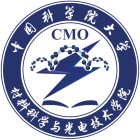
Soft X-rays provide a useful tool for studying electronic structures of energy materials and devices. Credit: University of Chinese Academy of Sciences
If there is one thing that distinguishes the College of Materials Science and Optoelectronic Technology (CMO) of University of Chinese Academy of Sciences (UCAS) from its peers, it is the integration of scientific research and teaching, which underpins its development strategy. Aiming to build first-class academic programmes for materials science and optic engineering, CMO is enhancing its faculty team, reinventing its talent training system, and has produced innovative research results.
Leading in research
CMO researchers are committed to developing cutting-edge technologies that address national strategic needs, and solving major problems in material science and engineering. Their high global standing arises from work in CMO’s six major research divisions: Semiconductor Materials and Technologies, focusing on next-generation semiconductor materials and devices, particularly, Si-based solar cells; Optoelectronic Materials and Technology, developing organic optoelectronic materials and devices; Advanced Energy Materials and Technologies, devising electrochemical energy storage materials, such as Li-ion, Na-ion, and metal air batteries, and key electro catalysts for liquid sunshine; Advanced Characterization Technology, studying the structure-performance relationship through techniques such as neutron diffraction, synchrotron x-ray, Raman and high-resolution electron microscopy; Computational Materials Science, emphasizing the first principle calculation and Density Functional Theory for advanced energy and functional materials; and Optical Engineering, with a focus on optoelectronic information system and applications, digital holography and photonic crystals.
The plasma-enhanced chemical vapor deposition assists semiconductor material preparation. Credit: University of Chinese Academy of Sciences
Significant examples include material design for lithium-ion, lithium-air and sodium-ion batteries. Researchers from CMO’s laboratory of advanced energy and functional materials have overcome the difficulty in synthesizing solid lithium superoxide (LiO2) to build an amorphous lithium-oxygen (Li-O2) battery based on LiO2. The battery’s ultra-low overpotential (~0.3V) means high-voltage efficiency and a long cycle life, opening the way to next-generation Li-O2 batteries with high energy density.
The team also came up with an integrated strategy to enhance electrochemical performances, which combines the advantages of Li2SnO3 coating, Sn doping and spinel phase junction, to tune the activity and reversibility of oxygen redox in lithium-rich cathode. This synergy suppresses lattice oxygen loss, improves the anionic redox activity and reversibility, and promotes Li-ion migration.
In material design CMO researchers proposed a model of multiple-scale interpenetrating network structure for easier manufacture of aerogel materials, widening their applications.
A new method for converting organic waste in urban runoff to high-performance organic semiconductors is another breakthrough by CMO scientists. To make the organic semiconductors the CMO team activated inert carbon sulphur bonds at room temperature. They also came up with the concept of ‘noncovalent conformational locks’, which becomes an important design principle for high performance organic/polymeric semiconductors. Their invention opens a new avenue for high-performance organic solar cells.
A removable battery mould developed at CMO. Credit: University of Chinese Academy of Sciences
CMO was founded in 2008 with the support of the Institute of Semiconductors, as well as 20-plus other institutes under the Chinese Academy of Sciences (CAS), such as the National Center of Nanoscience and Technology, Technical Institute of Physics and Chemistry, Academy of Optoelectronics, and the Institute of Physics. It now has a high-powered faculty team including 12 CAS members and 25 winners of the National Science Fund for Distinguished Young Scholars.
A strong educational programme
CMO offers 106 undergraduate and 170 graduate courses, serving students from UCAS and relevant CAS institutes. For material science students at UCAS, it offers four programmes: materials science and engineering (MSE), optical engineering, mechanic engineering, and instrumental science and technology. CMO incorporates basic courses with experiment and research, providing students great opportunity to hone hands-on skills.
Research strength of CMO graduate students is demonstrated by 8,842 articles published in journals included in the Science Citation Index (SCI) within the last five years, gaining a total of 96,535 citations, or 11 on average. The undergraduate education is also geared towards research, with more than 96% of CMO undergraduates continuing with post-graduate education, including many pursuing their studies at the world’s top ten universities, such as University of California-Berkeley and Columbia University in the United States, Swiss Federal Institute of Technology in Lausanne, and the Royal Swedish Institute of Technology.
CMO's battery testing system is state of the art. Credit: University of Chinese Academy of Sciences
In 2017, the MSE programme of UCAS was selected for the national ‘double first-class’ initiative, with funding to build into a ‘world-class discipline’. Latest ranking by Essential Science Indicators (ESI) in November 2018 placed UCAS number one among Chinese universities and fifth in the world in MSE.
Against the backdrop of the ‘double first-class’ initiative and the development of a science city in the Beijing suburb of Huairou, where UCAS is located, CMO is poised for further exploration, as well as education and staff training. Adhering to the mission of UCAS, which emphasizes the fusion of science and education, collaborative innovation, the essential role of education, and serving the country, CMO is striving to be a world-class education centre and an important hub for high-calibre research.


